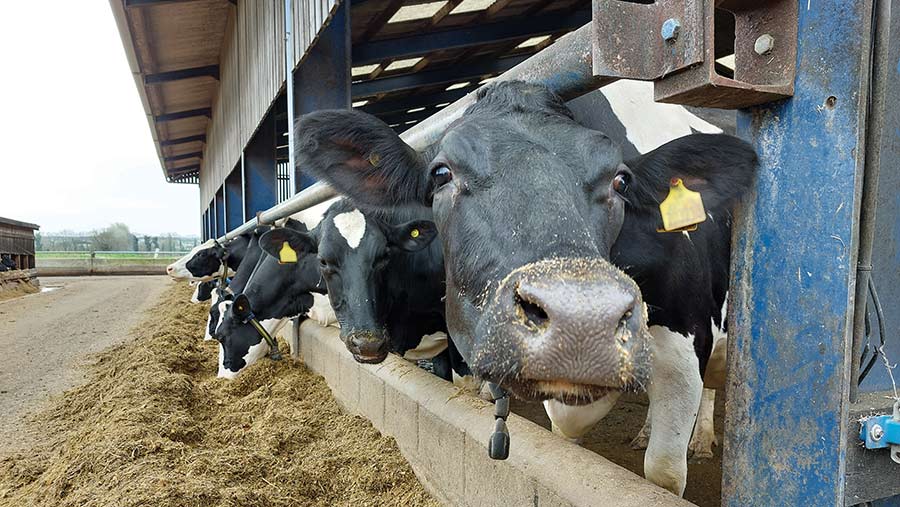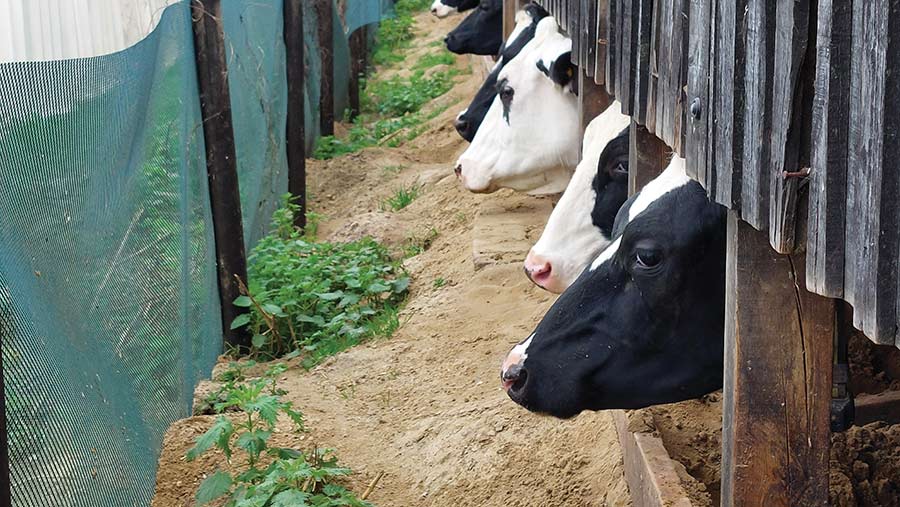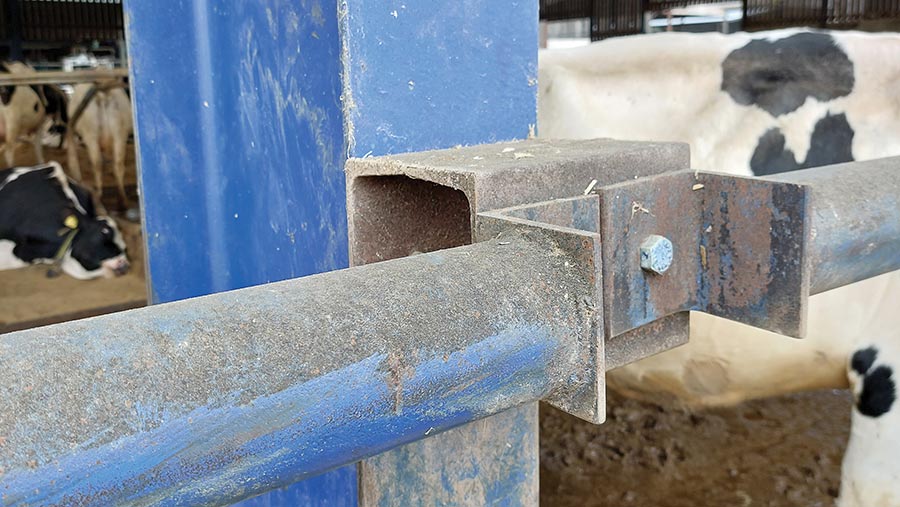A guide to giving cows grazing-level comfort indoors
 © MAG/Shirley Macmillan
© MAG/Shirley Macmillan Grazing-based herds may be housed for as little as two or three months a year to maximise the potential of grass intakes. As a result, they often have to make do with sub-standard housing.
Once out at grass again, they will bear the physical signs of poor cubicle dimensions, badly placed neck rails or broken concrete.
While problems may not be as acute as if cows were housed full time like this, LIC grazing consultant and Cow Signals trainer Piers Badnell says a cow housed under the same standard of comfort as at grass can produce another two lactations.
See also: Building for better herd health: Good floors
He advises observing cow behaviour after turnout to understand how winter accommodation may be compromising cow life and productivity.
“It’s a good time to look out for hock damage and neck callouses,” he says.
“Watch a cow as she gets up and lies down, see how her body works and how much room she needs. How can you make her life easier inside?
“Have a critical eye and look for the bottlenecks indoors. Then make a plan to fix things now. If you start to think about it in September, it will be too late, as you may get caught out by the weather and have to house early.”

A galebreaker can improve comfort while presenting as a barrier to the cows © Shirley Macmillan
Six freedoms
At grass, Piers says cows have everything they need: feed, water, light, air, room to rest, and space (with no restrictions) – what Cow Signals calls the “six freedoms”. They also have a natural lying surface.
He thinks many sheds above 10 years old will not meet all these freedoms. “You can have a shed that is very light with clear roof lights, but it doesn’t mean that it’s airy,” he points out.
Damage to hocks and knees, lumps on the spine or bruising all result from bad cubicle design and poor bedding. Further challenges occur when cubicles face walls, he adds.
“They do not give the cow free movement: she can’t lunge forward and has to turn her head to the left or right. She then scrabbles on the floor to get some purchase and, if there is no grip from the bed, this is where rubbing occurs, leading to hock abrasions. Sharp sawdust or sand bedding then create a sandpaper effect.”
When a cow is bruised or uncomfortable, Piers says she is less likely to get up and lie down, even though, at grass, her natural behaviour is to do this, on average, 25 times a day.
“She should be lying for 14 hours a day, but it could be as little as nine or 10 hours in poor housing. Less lying leads to less milk and more lameness,” he says.
A cow’s perfect day
- Rest (lying down) 14 hours
- Eating and drinking 6 hours
- Socialising 2 hours
- Milking 2 hours
Source: Piers Badnell
Deep bedding
Ideally, cubicles need a deep bed to give the cow a cushion to drop down onto. This also makes it easy for her to get out of a cubicle.
Piers suggests digging out cubicles or fixing a wooden batten about 10cm high to make a kerb at the back of the bed, to create depth to fill with bedding.
Similarly, reviewing the position of brisket boards or neck rails will help with cow position. “Generally, cows get up to pee and dung at grass.
In theory, boards and rails position the cow’s rear over the slurry channel and she is supposed to dung in it, but instead her tail lies in it.
“Furthermore, different-sized cows mean that some end up lying with their back over the channel. Small heifers lie forward in the bed and, because it’s uncomfortable to get up and down, they dung in the bed. If you get the dimensions right, about 98% of cows will get up to pee.”
Feed distribution
Feed space is another area to check. The recommended 75cm a head is not going to help intakes if rations are not delivered accurately along the whole length of the feed fence or trough, says Piers. Once intakes drop, cows can lose condition, which affects their fertility.
“When mature cows have had their fill, they lie down; heifers and timid cows get the leftovers. There needs to be feed distributed evenly across the feed space.
You don’t need to feed more than once a day – this complicates the system and dominant cows will still take priority. There is nothing wrong with pushing up as this stimulates intakes, but set it up right to make sure every cow gets their fill.”
A low feed rail will also influence intakes because it causes skin abrasions, which develop into neck callouses.
“Abrasions open the skin to infection. The bacteria Trueperella pyogenes, for instance, is found naturally on the skin. However, inside the cow’s bloodstream, it can lead to abortion,” he says.
“People worry that heifers or cows will get out if they raise the feed rail, [but] it just needs to be moved out using a spacer of about 4-5cm. This gives the cow more room to stretch her neck to reach feed, with less rub.”

A spacer can improve the position of the neck rail © MAG/Shirley Macmillan
Water flow
Water is another factor affecting feed intakes. This is not just an issue of supply and cleanliness but also involves cow behaviour.
“Remember that a dominant cow standing by the water trough won’t let others drink. It’s natural herd behaviour and you end up with waiting animals.
“Recognise this and supply enough troughs with a good flow so that cows can’t drink them dry.
“Troughs need cleaning out three times a week – weekly in hot weather – not forgetting around the ballcock,” says Piers.
Repairs to concrete flooring
Concrete past its best always needs attention. “Grippy, not slippy” is the target, as this gives cows confidence to express heats, which helps submission rates, he says.
A cow that is unstable on her feet has a bigger flight zone. This means that she becomes very stressed if a bully cow (or a human) enters the shed and she has to quickly get out of the way.
He advises replacing broken concrete or grooving slippery sections.
He also suggests considering the return on investment from rubber flooring in high traffic areas, such as corners where cows turn and risk getting white line disease.
Air flow
To improve airflow, Piers says a cost-effective method is to knock out breeze block walls – particularly external ones. This will improve light levels and give cows lunging space.
“The fear is that cows will get out and the weather in, leading to wet beds. However, if you put a false wall about 5-10ft [1.5-3m] away – either concrete panels or galebreaker – this will offer weather protection and, as the cow sees it, a barrier.
“I’m not saying you have to erect a cow palace for winter, but it is about how you spend your money to improve a cow’s life,” Piers says.
“There are easy, cheap solutions. And if you can get an extra two lactations from your cows, it means fewer dairy replacements are needed, which lowers replacement costs.”
